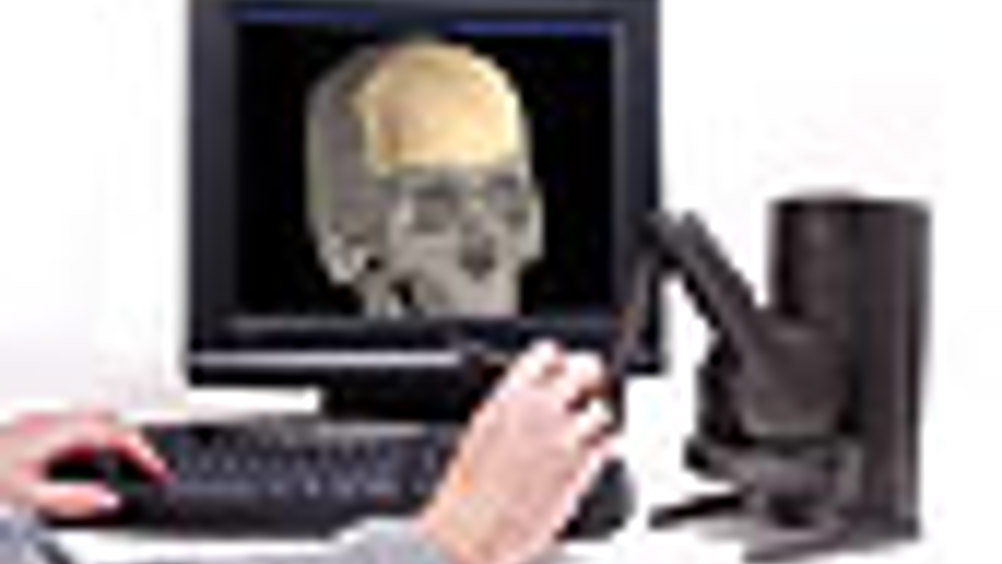Custom-build body parts

A Cardiff-based partnership is using 3D touch-based software to design prostheses to replace facial features that are damaged or missing through disease, hereditary conditions or injury.
The CARTIS (Centre for Applied Reconstructive Technologies in Surgery) group has brought together engineers and clinicians to custom-build body parts using SensAble Technologies' haptic system, FreeForm. the group was jointly established by Swansea NHS Trust's Maxillofacial Unit at Morriston Hospital and the National Centre for Product Design and Development Research (PDR) at the University of Wales Institute, Cardiff (UWIC).
Using FreeForm, the group can make virtual models using a hand-held tool — which resists as if they were shaping a physical lump of wax — and see their results in 3D on a screen.
The traditional method of constructing a replacement ear, for example, is a longer process, and involves taking a cast of the defective site and the remaining ear using silicone or alginate — a water and paste mix used in dental impressions. The prosthetic builder then hand-carves a reverse copy of the ear in wax, which is adjusted to the patient. This is used to make a three-part mould from which a silicone ear is cast and colour-matched to the patient. These steps can take up to three days, during which the patient stays in hospital.
Peter Evans, consultant in maxillary facial prosthetics at Morriston Hospital, explained: 'With FreeForm, we can input data from a patient's CT scan or use a 3D MD scanner. We take the shape of the remaining ear, reverse the image and then place it in the correct position on the target site.
'We do it all on-screen so it can be done before the patient even comes in to see us, saving time. We email the model to PDR to construct it in wax using a prototyping printer. The wax ear is then fitted directly on to the patient, any adjustments are made and it goes to crafting to make the final prosthesis.'
Evans said that ears are the most common facial feature that need replacing as they are prone to skin cancer, being bitten in fights or damaged in sports. Some children are even born without outer ears — a condition called microtia. He also treats cancer patients who have lost up to half of their faces, and require a prosthesis to give them dignity while undergoing treatment.
'With FreeForm we can do much more digitally before we approach the patient, which makes it a lot easier for them,' said Evans. 'The other benefit is we can do a good deal of the planning and design of a prosthesis to treat patients remotely all around the world. We've done that for cases in India and Japan.'
The group is also using the software to plan the attachment surgery more accurately.
'Prosthetics are held on by implants which are set into the bone and poke out of the skin,' said Evans. 'The position of the implant is critical, especially when dealing with a small child. Working with PDR using the stereolithographic model has been very useful in getting the position just right. We've seen a huge improvement in our results since then.'
Dominic Eggbeer, PDR's head of medical applications, said FreeForm is fundamental to the way his department works. 'It provides a very flexible way of engineering devices for reconstruction and enables us to design surgical guides, as well as creating soft-tissue prosthetics, contouring parts of anatomy for implants, making dental frameworks and cranioplasty contouring,' he said.
He explained that the CARTIS partnership itself was just as important as the software and the procedures it uses. 'It's absolutely fundamental to have both an engineering and medical understanding if you're going to work with patient-specific devices,' he said.
'You have to understand both sides of the requirements when you're using digital technology such as FreeForm or any of the associated prototyping technologies. Understanding how a prosthesis is designed requires knowledge of the capabilities and limitations of the engineering and medical side, and CARTIS has enabled that.'
Evans said that the new methods will not entirely replace traditional skills. 'If there's something that's quicker to carry out by hand — say a small bit of modelling that doesn't need scanning — we use old-hand techniques,' he said. 'We still teach those to our students as we wouldn't want them to go into a completely digital environment. Our aim is to integrate technology rather than let it take over.'
The team is now working on incorporating the very fine silicone edges that are needed to blend the prosthesis into the skin into the rapid-prototyping process.
Berenice Baker
Register now to continue reading
Thanks for visiting The Engineer. You’ve now reached your monthly limit of news stories. Register for free to unlock unlimited access to all of our news coverage, as well as premium content including opinion, in-depth features and special reports.
Benefits of registering
-
In-depth insights and coverage of key emerging trends
-
Unrestricted access to special reports throughout the year
-
Daily technology news delivered straight to your inbox










Water Sector Talent Exodus Could Cripple The Sector
Maybe if things are essential for the running of a country and we want to pay a fair price we should be running these utilities on a not for profit...